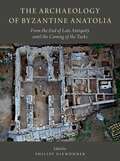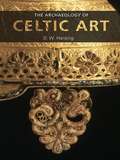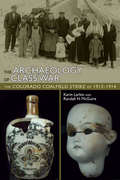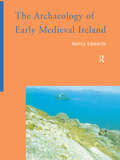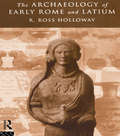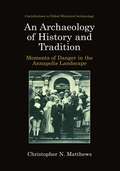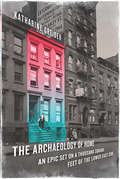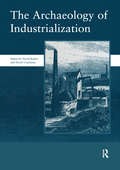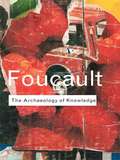- Table View
- List View
The Archaeology of Byzantine Anatolia: From the End of Late Antiquity until the Coming of the Turks
by Philipp NiewöhnerThis book accounts for the tumultuous period of the fifth to eleventh centuries from the Fall of Rome and the collapse of the Western Roman Empire through the breakup of the Eastern Roman Empire and loss of pan-Mediterranean rule, until the Turks arrived and seized Anatolia. The volume is divided into a dozen syntheses that each addresses an issue of intrigue for the archaeology of Anatolia, and two dozen case studies on single sites that exemplify its richness. Anatolia was the only major part of the Roman Empire that did not fall in late antiquity; it remained steadfast under Roman rule through the eleventh century. Its personal history stands to elucidate both the emphatic impact of Roman administration in the wake of pan-Mediterranean collapse. Thanks to Byzantine archaeology, we now know that urban decline did not set in before the fifth century, after Anatolia had already be thoroughly Christianized in the course of the fourth century; we know now that urban decline, as it occurred from the fifth century onwards, was paired with rural prosperity, and an increase in the number, size, and quality of rural settlements and in rural population; that this ruralization was halted during the seventh to ninth centuries, when Anatolia was invaded first by the Persians, and then by the Arabs---and the population appears to have sought shelter behind new urban fortifications and in large cathedrals. Further, it elucidates that once the Arab threat had ended in the ninth century, this ruralization set in once more, and most cities seem to have been abandoned or reduced to villages during the ensuing time of seeming tranquility, whilst the countryside experienced renewed prosperity; that this trend was reversed yet again, when the Seljuk Turks appeared on the scene in the eleventh century, devastated the countryside and led to a revival and refortification of the former cities. This dynamic historical thread, traced across its extremes through the lens of Byzantine archaeology, speaks not only to the torrid narrative of Byzantine Anatolia, but to the enigmatic medievalization.
The Archaeology of Capitalism in Colonial Contexts: Postcolonial Historical Archaeologies (Contributions To Global Historical Archaeology)
by Sarah K. K. Croucher and Lindsay WeissThe Archaeology of Capitalism in Colonial Contexts: Postcolonial Historical Archaeologies explores the complex interplay of colonial and capital formations throughout the modern world. The authors present a critical approach to this topic, trying to shift discourses in the theoretical framework of historical archaeology of capitalism and colonialism through the use of postcolonial theory. This work does not suggest a new theoretical framework as such, but rather suggests the importance of revising key theoretical terms employed within historical archaeology, arguing for new engagements with postcolonial theory of relevance to all historical archaeologists as the field de-centers from its traditional locations. Examining case studies from North America, South America, the Caribbean, Africa, Australia, the Middle East, and Europe, the chapters offer an unusually broad ranging geography of historical archaeology, with each focused on the interplay between the particularisms of colonial structures and the development of capitalism and wider theoretical discussions. Every author also draws attention to the ramifications of their case studies in the contemporary world. With its cohesive theoretical framework this volume is a key resource for those interested in decolonizing historical archaeology in theory and praxis, and for those interested in the development of modern global dynamics.
The Archaeology of Celtic Art
by D.W. HardingMore wide ranging, both geographically and chronologically, than any previous study, this well-illustrated book offers a new definition of Celtic art. Tempering the much-adopted art-historical approach, D.W. Harding argues for a broader definition of Celtic art and views it within a much wider archaeological context. He re-asserts ancient Celtic identity after a decade of deconstruction in English-language archaeology. Harding argues that there were communities in Iron Age Europe that were identified historically as Celts, regarded themselves as Celtic, or who spoke Celtic languages, and that the art of these communities may reasonably be regarded as Celtic art. This study will be indispensable for those people wanting to take a fresh and innovative perspective on Celtic Art.
The Archaeology of Celtic Art
by D.W. HardingMore wide ranging, both geographically and chronologically, than any previous study, this well-illustrated book offers a new definition of Celtic art. Tempering the much-adopted art-historical approach, D.W. Harding argues for a broader definition of Celtic art and views it within a much wider archaeological context. He re-asserts ancient Celtic identity after a decade of deconstruction in English-language archaeology. Harding argues that there were communities in Iron Age Europe that were identified historically as Celts, regarded themselves as Celtic, or who spoke Celtic languages, and that the art of these communities may reasonably be regarded as Celtic art. This study will be indispensable for those people wanting to take a fresh and innovative perspective on Celtic Art.
The Archaeology of Class War: The Colorado Coalfield Strike of 1913-1914
by Karin Larkin Randall H. McGuireThe Archaeology of the Colorado Coalfield War Project has conducted archaeological investigations at the site of the Ludlow Massacre in Ludlow, Colorado, since 1996. With the help of the United Mine Workers of America and funds from the Colorado State Historical Society and the Colorado Endowment for the Humanities, the scholars involved have integrated archaeological finds with archival evidence to show how the everyday experiences of miners and their families shaped the strike and its outcome.The Archaeology of Class War weaves together material culture, documents, oral histories, landscapes, and photographs to reveal aspects of the strike and life in early twentieth-century Colorado coalfields unlike any standard documentary history. Excavations at the site of the massacre and the nearby town of Berwind exposed tent platforms, latrines, trash dumps, and the cellars in which families huddled during the attack. Myriad artifacts—from canning jars to a doll’s head—reveal the details of daily existence and bring the community to life.The Archaeology of Class War will be of interest to archaeologists, historians, and general readers interested in mining and labor history.
An Archaeology of Colonial Identity: Power and Material Culture in the Dwars Valley, South Africa (Contributions To Global Historical Archaeology)
by Gavin LucasThe Archaeology of Early Medieval and Medieval South Asia: Contesting Narratives from the Eastern Ganga-Brahmaputra Basin
by Swadhin Sen Supriya Varma Bhairabi Prasad SahuThis book looks at the ways in which archaeological methods have been used in debates concerning the early medieval and medieval periods in South Asia. Despite the incorporation and use of archaeological data to corroborate historical narratives, the theories and methods of archaeology are largely ignored in and excluded from the dominating, institutionalized and hegemonic disciplinary discourses. The volume offers contesting insights, polemical narratives, and new data from archaeological contexts to initiate a debate on many foundational premises of archaeological and historical narratives. It focuses on the much-neglected region of the Eastern Ganga-Brahmaputra Basin as a spatial frame to do this, and studies themes such as spatial and temporal scales of concepts and methods, multi-scaler factors and processes of continuity and changes, the settlement archaeology on alluvial landscape, changing patterns of agrarian transformation, and material cultures, including coins, inscriptions, pottery, sculptures, in their contexts in sub-regional, regional and supra-regional intersections. As a crucial and unprecedented intervention in the study of the early medieval and the medieval periods, this volume will be useful for scholars and researchers of archaeology, ancient history, medieval history, water history, earth sciences, palaeoecology, historical ecology, epigraphy, art history, material culture studies, Indian history, and South Asian Studies in general.
The Archaeology of Early Medieval and Medieval South Asia: Contesting Narratives from the Eastern Ganga-Brahmaputra Basin
by Swadhin Sen, Supriya Varma, and Bhairabi Prasad SahuThis book looks at the ways in which archaeological methods have been used in debates concerning the early medieval and medieval periods in South Asia. Despite the incorporation and use of archaeological data to corroborate historical narratives, the theories and methods of archaeology are largely ignored in and excluded from the dominating, institutionalized and hegemonic disciplinary discourses. The volume offers contesting insights, polemical narratives, and new data from archaeological contexts to initiate a debate on many foundational premises of archaeological and historical narratives. It focuses on the much-neglected region of the Eastern Ganga-Brahmaputra Basin as a spatial frame to do this, and studies themes such as spatial and temporal scales of concepts and methods, multi-scaler factors and processes of continuity and changes, the settlement archaeology on alluvial landscape, changing patterns of agrarian transformation, and material cultures, including coins, inscriptions, pottery, sculptures, in their contexts in sub-regional, regional and supra-regional intersections. As a crucial and unprecedented intervention in the study of the early medieval and the medieval periods, this volume will be useful for scholars and researchers of archaeology, ancient history, medieval history, water history, earth sciences, palaeoecology, historical ecology, epigraphy, art history, material culture studies, Indian history, and South Asian Studies in general.
The Archaeology of Early Medieval Ireland
by Nancy EdwardsIn the first major work on the subject for over 30 years, Nancy Edwards provides a critical survey of the archaeological evidence in Ireland (c. 400-1200), introducing material from many recently discovered sites as well as reassessing the importance of earlier excavations. Beginning with an assessment of Roman influence, Dr Edwards then discusses the themse of settlement, food and farming, craft and technology, the church and art, concluding with an appraisal of the Viking impact. The archaeological evidence for the period is also particularly rich and wide-ranging and our knowledge is expanding repidly in the light of modern techniques of survey and excavation.
The Archaeology of Early Medieval Ireland
by Nancy EdwardsIn the first major work on the subject for over 30 years, Nancy Edwards provides a critical survey of the archaeological evidence in Ireland (c. 400-1200), introducing material from many recently discovered sites as well as reassessing the importance of earlier excavations. Beginning with an assessment of Roman influence, Dr Edwards then discusses the themse of settlement, food and farming, craft and technology, the church and art, concluding with an appraisal of the Viking impact. The archaeological evidence for the period is also particularly rich and wide-ranging and our knowledge is expanding repidly in the light of modern techniques of survey and excavation.
The Archaeology of Early Rome and Latium
by Ross R. HollowayThe archaeology of early Rome has progressed rapidly and dramatically over the last century; most recently with the discovery of the shrine of Aeneas at Lavinium and the reports of the walls of the Romulan city discovered on the city slopes of the Palatine Hill. The Archaeology of Early Rome and Latium presents the most recent discoveries in Rome and its surroundings: princely tombs,inscriptions and patrician houses are included in a complete overview of the subject and the controversies surrounding it.This comprehensively illustrated study fills the need for an accessible English guide to these new discoveries, and in preparation, the author interviewed most of the leading figures in current research on the early periods of Rome.
The Archaeology of Early Rome and Latium
by Ross R. HollowayThe archaeology of early Rome has progressed rapidly and dramatically over the last century; most recently with the discovery of the shrine of Aeneas at Lavinium and the reports of the walls of the Romulan city discovered on the city slopes of the Palatine Hill. The Archaeology of Early Rome and Latium presents the most recent discoveries in Rome and its surroundings: princely tombs,inscriptions and patrician houses are included in a complete overview of the subject and the controversies surrounding it.This comprehensively illustrated study fills the need for an accessible English guide to these new discoveries, and in preparation, the author interviewed most of the leading figures in current research on the early periods of Rome.
The Archaeology of Greece and Rome: Image, Text and Context. Studies In Honour of Anthony Snodgrass
by John Bintliff Keith RutterOver his long and illustrious career as Lecturer, Reader and Professor in Edinburgh University (1961-1976), Lawrence Professor of Classical Archaeology at Cambridge (1976-2001) and currently Fellow of the McDonald Institute of Archaeology at Cambridge, Anthony Snodgrass has influenced and been associated with a long series of eminent classical archaeologists, historians and linguists. In acknowledgement of his immense academic achievement, this collection of essays by a range of international scholars reflects his wide-ranging research interests: Greek prehistory, the Greek Iron Age and Archaic era, Greek texts and Archaeology, Classical Art History, societies on the fringes of the Greek and Roman world, and Regional Field Survey. Not only do they celebrate his achievements but they also represent new avenues of research which will have a broad appeal.
The Archaeology of Greece and Rome: Image, Text and Context. Studies In Honour of Anthony Snodgrass
by John Bintliff Keith RutterOver his long and illustrious career as Lecturer, Reader and Professor in Edinburgh University (1961-1976), Lawrence Professor of Classical Archaeology at Cambridge (1976-2001) and currently Fellow of the McDonald Institute of Archaeology at Cambridge, Anthony Snodgrass has influenced and been associated with a long series of eminent classical archaeologists, historians and linguists. In acknowledgement of his immense academic achievement, this collection of essays by a range of international scholars reflects his wide-ranging research interests: Greek prehistory, the Greek Iron Age and Archaic era, Greek texts and Archaeology, Classical Art History, societies on the fringes of the Greek and Roman world, and Regional Field Survey. Not only do they celebrate his achievements but they also represent new avenues of research which will have a broad appeal.
An Archaeology of History and Tradition: Moments of Danger in the Annapolis Landscape (Contributions To Global Historical Archaeology)
by Christopher N. MatthewsAs the foundations of the modern world were being laid at the beginning of the 19th century, Annapolis, Maryland, identified itself as the Ancient City. This unusual appellation has served Annapolis into the present as a city that has consistently defined and redefined for itself what being ancient means. The process of historical recognition and preservation that has played out in Annapolis provides valuable insights into the way modern Americans in general have come to know and use the past. Though often conceived to be in opposition, modernity and tradition can be paired as cultural strategies that allow the modern world to be articulated with the tradition it hoped to replace. The multiple histories and historic landscapes derived from archaeological investigations in Annapolis are presented to show that the physical world below the surface of the city has been defined by constructions of modernity in tandem with the survival of certain traditions.
The Archaeology of Home: An Epic Set on a Thousand Square Feet of the Lower East Side
by Katharine GreiderWhen Katharine Greider was told to leave her house or risk it falling down on top of her and her family, it spurred an investigation that began with contractors' diagnoses and lawsuits, then veered into archaeology and urban history, before settling into the saltwater grasses of the marsh that fatefully once sat beneath the site of Number 239 East 7th Street.During the journey, Greider examines how people balance the need for permanence with the urge to migrate, and how the home is the resting place for ancestral ghosts. The land on which Number 239 was built has a history as long as America's own. It provisioned the earliest European settlers who needed fodder for their cattle; it became a spoil of war handed from the king's servant to the revolutionary victor; it was at the heart of nineteenth-century Kleinedeutschland and of the revolutionary Jewish Lower East Side. America's immigrant waves have all passed through 7th Street. In one small house is written the history of a young country and the much longer story of humankind and the places they came to call home.
The Archaeology of Industrialization: Society of Post-Medieval Archaeology Monographs
by David Barker David CranstoneThis book is the outcome of the first joint conference of the two country's foremost societies devoted to the archaeological study of the early-modern and modern worlds. It discusses the progress of industrialization and its impact upon modern society.
The Archaeology of Industrialization: Society of Post-Medieval Archaeology Monographs
by David Barker David CranstoneThis book is the outcome of the first joint conference of the two country's foremost societies devoted to the archaeological study of the early-modern and modern worlds. It discusses the progress of industrialization and its impact upon modern society.
An archaeology of innovation: Approaching social and technological change in human society (Social Archaeology and Material Worlds)
by Catherine J. FriemanAn archaeology of innovation is the first monograph-length investigation of innovation and the innovation process from an archaeological perspective. It interrogates the idea of innovation that permeates our popular media and our political and scientific discourse, setting this against the long-term perspective that only archaeology can offer. Case studies span the entire breadth of human history, from our earliest hominin ancestors to the contemporary world. The book argues that the present narrow focus on pushing the adoption of technical innovations ignores the complex interplay of social, technological and environmental systems that underlies truly innovative societies; the inherent connections between new technologies, technologists and social structure that give them meaning and make them valuable; and the significance and value of conservative social practices that lead to the frequent rejection of innovations.
An archaeology of innovation: Approaching social and technological change in human society (Social Archaeology and Material Worlds)
by Catherine J. FriemanAn archaeology of innovation is the first monograph-length investigation of innovation and the innovation process from an archaeological perspective. It interrogates the idea of innovation that permeates our popular media and our political and scientific discourse, setting this against the long-term perspective that only archaeology can offer. Case studies span the entire breadth of human history, from our earliest hominin ancestors to the contemporary world. The book argues that the present narrow focus on pushing the adoption of technical innovations ignores the complex interplay of social, technological and environmental systems that underlies truly innovative societies; the inherent connections between new technologies, technologists and social structure that give them meaning and make them valuable; and the significance and value of conservative social practices that lead to the frequent rejection of innovations.
Archaeology of Iran in the Historical Period (University of Tehran Science and Humanities Series)
by Kamal-Aldin Niknami Ali HozhabriThis collection of twenty-eight essays presents an up-to-date survey of pre-Islamic Iran, from the earliest dynasty of Illam to the end of Sasanian empire, encompassing a rich diversity of peoples and cultures. Historically, Iran served as a bridge between the earlier Near Eastern cultures and the later classical world of the Mediterranean, and had a profound influence on political, military, economic, and cultural aspects of the ancient world. Written by international scholars and drawing mainly on the field of practical archaeology, which traditionally has shared little in the way of theories and methods, the book provides crucial pieces to the puzzle of the national identity of Iranian cultures from a historical perspective. Revealing the wealth and splendor of ancient Iranian society – its rich archaeological data and sophisticated artistic craftsmanship – most of which has never before been presented outside of Iran, this beautifully illustrated book presents a range of studies addressing specific aspects of Iranian archaeology to show why the artistic masterpieces of ancient Iranians rank among the finest ever produced. Together, the authors analyze how archaeology can inform us about our cultural past, and what remains to still be discovered in this important region.
Archaeology of Jesus' Nazareth
by Ken DarkArchaeology of Jesus' Nazareth is the first book on the archaeology of first-century Nazareth: Jesus' hometown in Galilee. Requiring no previous knowledge of biblical history or archaeology, it outlines the latest archaeological evidence, placing the Gospels' account of Jesus' youth in the Bible, and origins of Christian pilgrimage, in a new context. The book concentrates on the fascinating Sisters of Nazareth site in the centre of the present city. There, twenty-first century archaeological research identified a Byzantine pilgrimage church, which is likely to be the Church of the Nutrition - dedicated to the upbringing of Christ - the most important previously 'lost' early Christian church in the Holy Land. A seventh-century pilgrim said that a vaulted area under the Church of the Nutrition contained the actual house where Jesus was brought up by Mary and Joseph. Intriguingly, below the Byzantine church at the Sisters of Nazareth site a vaulted area preserved what are probably the ruins of a first-century house. Even before the Byzantine church was built, a - probably fourth-century - cave-church was constructed next to the first-century ruins, suggesting that they were assigned Christian religious importance. The similarities with the pilgrim's description raise the question of whether the Sisters of Nazareth house really could have been the childhood home of Jesus. The book draws to its conclusion by means of a discussion of this historical existence for Jesus and the implications of the archaeology of Nazareth for understanding the Gospels.
Archaeology of Jesus' Nazareth
by Ken DarkArchaeology of Jesus' Nazareth is the first book on the archaeology of first-century Nazareth: Jesus' hometown in Galilee. Requiring no previous knowledge of biblical history or archaeology, it outlines the latest archaeological evidence, placing the Gospels' account of Jesus' youth in the Bible, and origins of Christian pilgrimage, in a new context. The book concentrates on the fascinating Sisters of Nazareth site in the centre of the present city. There, twenty-first century archaeological research identified a Byzantine pilgrimage church, which is likely to be the Church of the Nutrition - dedicated to the upbringing of Christ - the most important previously 'lost' early Christian church in the Holy Land. A seventh-century pilgrim said that a vaulted area under the Church of the Nutrition contained the actual house where Jesus was brought up by Mary and Joseph. Intriguingly, below the Byzantine church at the Sisters of Nazareth site a vaulted area preserved what are probably the ruins of a first-century house. Even before the Byzantine church was built, a - probably fourth-century - cave-church was constructed next to the first-century ruins, suggesting that they were assigned Christian religious importance. The similarities with the pilgrim's description raise the question of whether the Sisters of Nazareth house really could have been the childhood home of Jesus. The book draws to its conclusion by means of a discussion of this historical existence for Jesus and the implications of the archaeology of Nazareth for understanding the Gospels.
Archaeology of Knowledge
by Michel FoucaultIn France, a country that awards its intellectuals the status other countries give their rock stars, Michel Foucault was part of a glittering generation of thinkers, one which also included Sartre, de Beauvoir and Deleuze. One of the great intellectual heroes of the twentieth century, Foucault was a man whose passion and reason were at the service of nearly every progressive cause of his time. From law and order, to mental health, to power and knowledge, he spearheaded public awareness of the dynamics that hold us all in thrall to a few powerful ideologies and interests. Arguably his finest work, Archaeology of Knowledge is a challenging but fantastically rewarding introduction to his ideas.
Archaeology of Knowledge
by Michel FoucaultIn France, a country that awards its intellectuals the status other countries give their rock stars, Michel Foucault was part of a glittering generation of thinkers, one which also included Sartre, de Beauvoir and Deleuze. One of the great intellectual heroes of the twentieth century, Foucault was a man whose passion and reason were at the service of nearly every progressive cause of his time. From law and order, to mental health, to power and knowledge, he spearheaded public awareness of the dynamics that hold us all in thrall to a few powerful ideologies and interests. Arguably his finest work, Archaeology of Knowledge is a challenging but fantastically rewarding introduction to his ideas.
